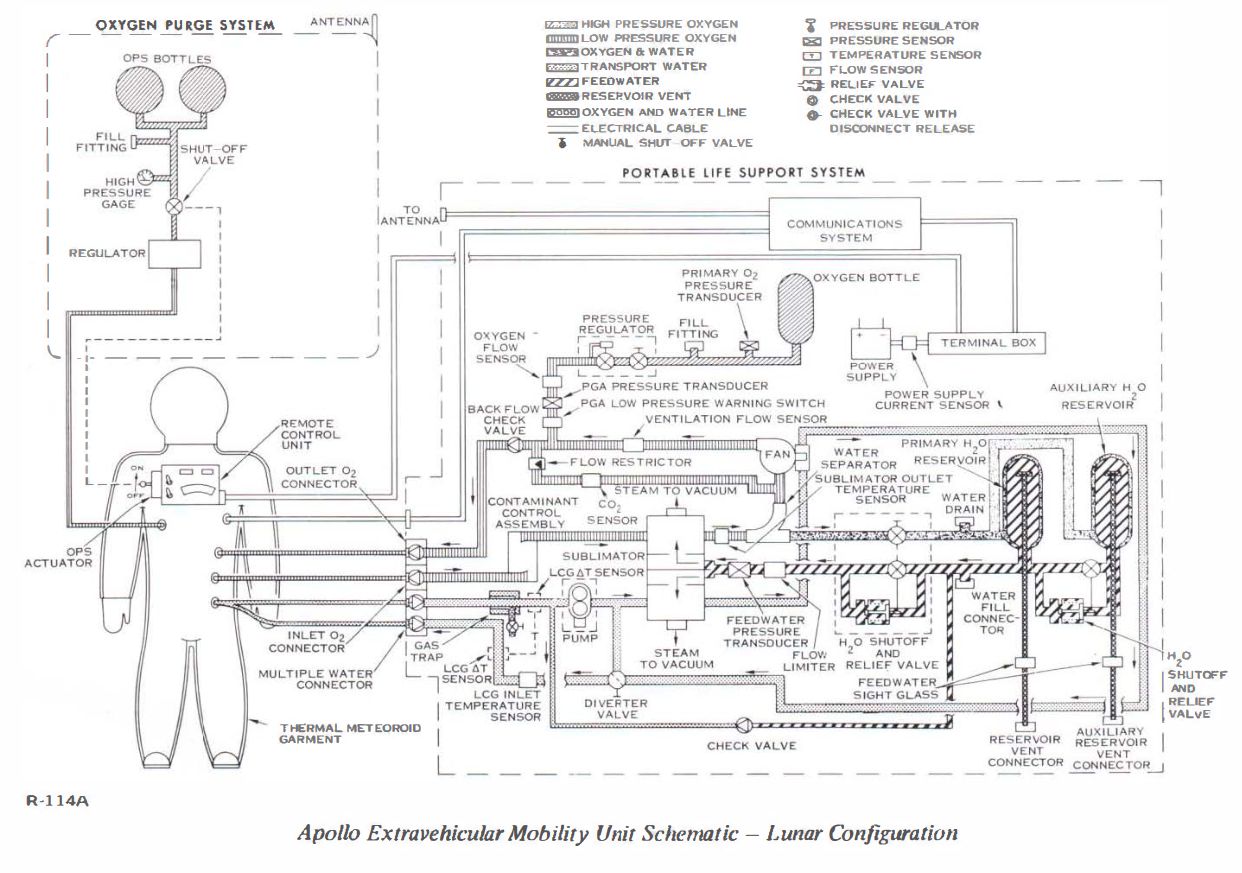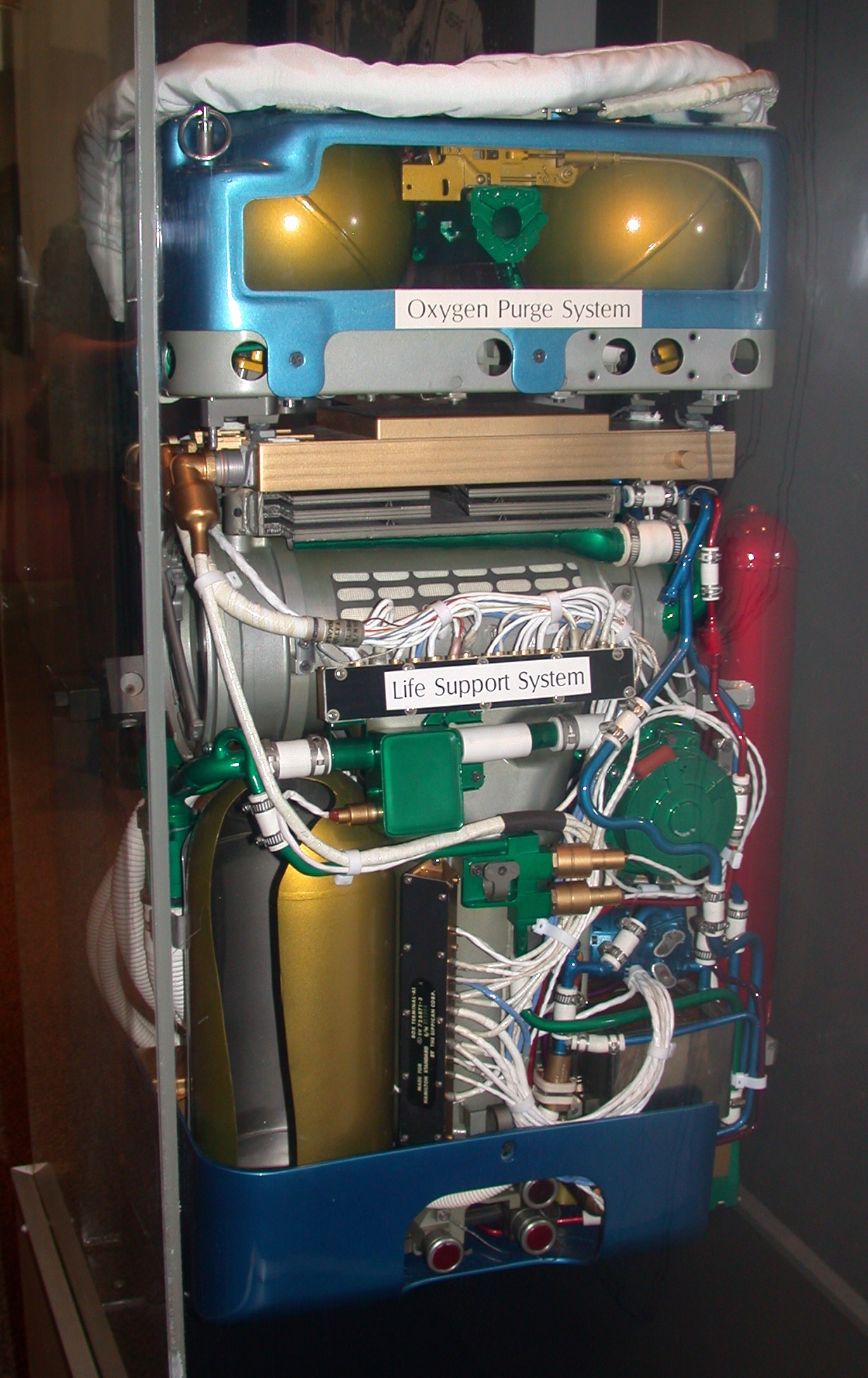Winston
Lorenzo von Matterhorn
- Joined
- Jan 31, 2009
- Messages
- 9,560
- Reaction score
- 1,748
Apollo Portable Life Support System (PLSS)
https://hackaday.com/2019/08/19/apollos-plss-and-the-science-of-keeping-humans-alive-in-space/
Excerpts:
The PLSS as used with the Apollo Moon missions had a range of functions:
Regulate spacesuit pressure.
Provide fresh oxygen to replenish oxygen levels in circulation.
Remove CO2, humidity (water), odors and other contaminants from the oxygen.
Cool the oxygen as it circulates.
Cool and circulate cooling water through tubing in the suit.
Provide two-way voice communication.
Receive and transmit telemetry of sensors indicating the wearer’s vital signs.
This document (PDF) from Hamilton Standard covers the PLSS system in great detail:
https://www.hq.nasa.gov/alsj/LM15_Portable_Life_Support_System_ppP1-5.pdf
The cooling of the circulating oxygen and water is accomplished by leading it past a sublimator: a device consisting out of porous plates through which water is being forced. Upon contact with the vacuum of space, the water freezes into ice, after which it sublimates from this solid phase into gas. This endothermic process causes the sintered nickel plates of the sublimator to become very cold, cooling any oxygen and water that is led over it.
The sublimating process is self-regulating, in that the rate of vapor formation depends on the amount of heat that is applied to the device. The pressure that forces the feed water into the sublimator’s plates is provided by the squeezing of the feed water bladder that’s placed between the PLLS and the user’s back. Though fairly compact, this sublimator can dissipate over 2 MJ (2,000 BTU) peak, making it the equivalent of an air conditioning unit sized for a bedroom. This allows a human in the full heat of a Moon day to stay nice and cool.
With each part of the PLSS being essentially a single point of failure, a backup system was provided in the form of the Oxygen Purge System (OPS), another oxygen providing system mounted on the top of the PLSS pack. This could be triggered in case the primary oxygen supply failed, providing oxygen and cooling (from the oxygen depressurizing outside the OPS oxygen tank) for 30-90 minutes, depending on flowrate. This is an open-circuit system, venting out into space.
Another backup is the ‘Buddy secondary life support system’, whereby another astronaut can use their functioning cooling system to cool a second suit if its PLSS’ cooling system fails. With external cooling, the OPS’ operational time can be extended from 30 minutes to 60-90 minutes.
Naturally, each PLSS is also equipped with a transceiver system, allowing for bidirectional communications not only with their fellow astronauts, but also with the control center at Earth. This would prove to be invaluable during each mission, while navigating the terrain and setting up experiments. The psychological comfort of constant contact also shouldn’t be underestimated.


https://hackaday.com/2019/08/19/apollos-plss-and-the-science-of-keeping-humans-alive-in-space/
Excerpts:
The PLSS as used with the Apollo Moon missions had a range of functions:
Regulate spacesuit pressure.
Provide fresh oxygen to replenish oxygen levels in circulation.
Remove CO2, humidity (water), odors and other contaminants from the oxygen.
Cool the oxygen as it circulates.
Cool and circulate cooling water through tubing in the suit.
Provide two-way voice communication.
Receive and transmit telemetry of sensors indicating the wearer’s vital signs.
This document (PDF) from Hamilton Standard covers the PLSS system in great detail:
https://www.hq.nasa.gov/alsj/LM15_Portable_Life_Support_System_ppP1-5.pdf
The cooling of the circulating oxygen and water is accomplished by leading it past a sublimator: a device consisting out of porous plates through which water is being forced. Upon contact with the vacuum of space, the water freezes into ice, after which it sublimates from this solid phase into gas. This endothermic process causes the sintered nickel plates of the sublimator to become very cold, cooling any oxygen and water that is led over it.
The sublimating process is self-regulating, in that the rate of vapor formation depends on the amount of heat that is applied to the device. The pressure that forces the feed water into the sublimator’s plates is provided by the squeezing of the feed water bladder that’s placed between the PLLS and the user’s back. Though fairly compact, this sublimator can dissipate over 2 MJ (2,000 BTU) peak, making it the equivalent of an air conditioning unit sized for a bedroom. This allows a human in the full heat of a Moon day to stay nice and cool.
With each part of the PLSS being essentially a single point of failure, a backup system was provided in the form of the Oxygen Purge System (OPS), another oxygen providing system mounted on the top of the PLSS pack. This could be triggered in case the primary oxygen supply failed, providing oxygen and cooling (from the oxygen depressurizing outside the OPS oxygen tank) for 30-90 minutes, depending on flowrate. This is an open-circuit system, venting out into space.
Another backup is the ‘Buddy secondary life support system’, whereby another astronaut can use their functioning cooling system to cool a second suit if its PLSS’ cooling system fails. With external cooling, the OPS’ operational time can be extended from 30 minutes to 60-90 minutes.
Naturally, each PLSS is also equipped with a transceiver system, allowing for bidirectional communications not only with their fellow astronauts, but also with the control center at Earth. This would prove to be invaluable during each mission, while navigating the terrain and setting up experiments. The psychological comfort of constant contact also shouldn’t be underestimated.





